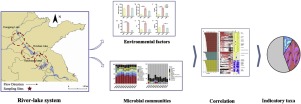Microbiological Research ( IF 6.1 ) Pub Date : 2020-03-05 , DOI: 10.1016/j.micres.2020.126453 Jian-Lu Duan 1 , Jia-Wen Sun 1 , Meng-Meng Ji 1 , Yue Ma 2 , Zi-Teng Cui 2 , Ru-Kang Tian 1 , Peng-Cheng Xu 1 , Wen-Lin Sun 1 , Xian-Zheng Yuan 1

|
Sulfate related water quality and trophic status are crucial to operation of water diversion. Though the sulfur geochemistry in the lake sediment have been well studied, the effective indicator of surrounding environment conditions related to sulfur in river-lake systems are still unknown. In this study, Dongping Lake (DPH), Weishan Lake (WSH), and Hanzhuang trunk canal (HZQ) were selected as the typical river-lake systems in the eastern of China. Different spatial variations in sedimentary sulfate, total sulfur, and elemental composition of sediments were investigated in these areas. The relatively high sulfate in surface water and sediments appeared in portions of WSH. The biodiversity of HZQ and WSH surface sediments was much higher than that of DPH. Pseudomonas, Acinetobacter, and Thiobacillus were the dominant genera of the river-lake systems. Among the different genera in distribution, genera such as Malikia, Sulfurovum and Lysinibacillus were significantly negatively correlated with sulfur related environmental factors. While the genera such as Pseudomonas, Vogesella and Acinetobacter were significantly positively correlated with these factors. Compared with connectivity in the largest interaction network, bacteria such as Proteus, Acidobacter and Chlorobacteria were identified as indicatory taxa to infer sulfate related conditions in the river-lake systems.











































 京公网安备 11010802027423号
京公网安备 11010802027423号